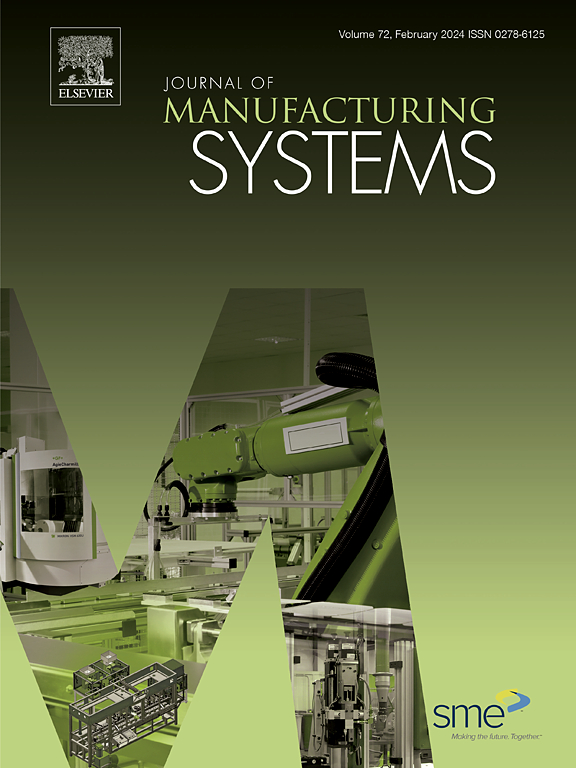面向多产业场景的SD-LDM数字孪生构建策略:增强适应性和效率
IF 14.2
1区 工程技术
Q1 ENGINEERING, INDUSTRIAL
引用次数: 0
摘要
在快速发展的工业5.0环境中,数字孪生(DT)已成为跨各个工业部门的变革性技术。然而,随着DT理论和实践的发展,一个关键问题出现了:与实施DT相关的构建时间延长。针对这一挑战,本文提出了一种快速的数字孪生构建方法:面向多场景的llm引导SD-LDM数字孪生构建策略(LSDT)。首先,我们介绍了一个跨模态生成框架。该框架利用大语言模型(LLM)-引导稳定扩散-潜在扩散模型(SD-LDM)技术,能够基于有限的多模态数据快速构建高质量的3D模型。随后,将生成的模型转移到数字孪生构建框架中。该框架结合了DT构建方法和装配融合方法,实现了多尺度、多层次的DT构建。最后,我们在研发实验室、原型仓库和包装单位进行了案例研究。多维评分结果表明,模型构建效率显著提高,模型构建效率峰值达到39 %(跨模型)和73 %(单模型),可用性得分最高达到13.84。此外,构建的DT成功满足了场景的核心Ss要求。结果表明,LSDT方法加快了DT构造的效率,具有良好的适应性。本文章由计算机程序翻译,如有差异,请以英文原文为准。
An LLM-guided SD-LDM Digital Twin Construction Strategy (LSDT) for multi-industrial scenarios: Enhancing adaptability and efficiency
In the rapidly evolving landscape of Industry 5.0, Digital Twin (DT) have emerged as a transformative technology across various industrial sectors. However, as DT theory and practice progress, a critical issue arises: the prolonged building time associated with implementing DTs. To address this challenge, this paper proposes a rapid DT construction method: LLM-Guided SD-LDM Digital Twin Construction Strategy (LSDT) for multi-scenarios. Firstly, we introduce a cross-modal generation framework. This framework leverages Large Language Model (LLM)-Guided Stable Diffusion- Latent Diffusion Model (SD-LDM) technology, which is capable of swiftly constructing high-quality 3D models based on limited multimodal data. Subsequently, the generated models are transferred into the Digital twin construction framework. This framework incorporates both the DT construction method and the assembly and fusion method, enabling the realization of a multi-scale, multi-level DT construction. Finally, we conducted case study in R&D laboratories, prototype warehouses, and packaging units. The multi-dimensional scoring results showed that the model construction efficiency improved significantly, with peak values reaching 39 % (across models) and 73 % (single model), while usability scores peaked at 13.84. Furthermore, the constructed DT successfully met the core Ss requirements of the scenarios. These results indicate that the LSDT method accelerates the efficiency for DT construction and offers good adaptability.
求助全文
通过发布文献求助,成功后即可免费获取论文全文。
去求助
来源期刊

Journal of Manufacturing Systems
工程技术-工程:工业
CiteScore
23.30
自引率
13.20%
发文量
216
审稿时长
25 days
期刊介绍:
The Journal of Manufacturing Systems is dedicated to showcasing cutting-edge fundamental and applied research in manufacturing at the systems level. Encompassing products, equipment, people, information, control, and support functions, manufacturing systems play a pivotal role in the economical and competitive development, production, delivery, and total lifecycle of products, meeting market and societal needs.
With a commitment to publishing archival scholarly literature, the journal strives to advance the state of the art in manufacturing systems and foster innovation in crafting efficient, robust, and sustainable manufacturing systems. The focus extends from equipment-level considerations to the broader scope of the extended enterprise. The Journal welcomes research addressing challenges across various scales, including nano, micro, and macro-scale manufacturing, and spanning diverse sectors such as aerospace, automotive, energy, and medical device manufacturing.
 求助内容:
求助内容: 应助结果提醒方式:
应助结果提醒方式:


